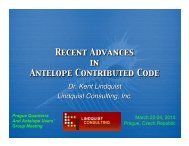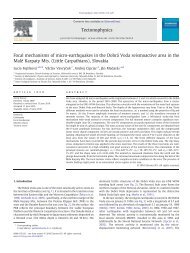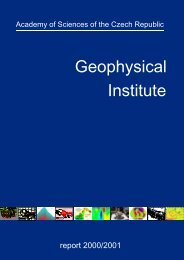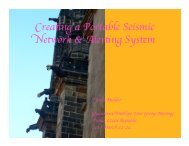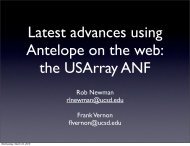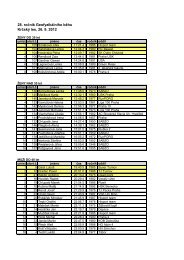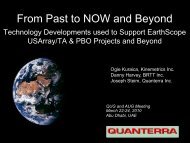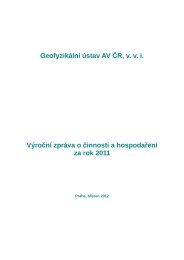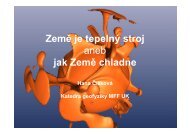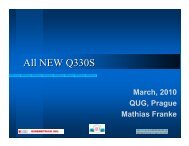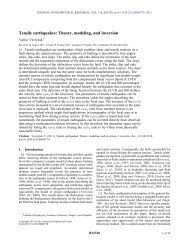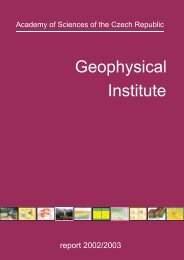Geophysical Institute of the ASCR
Geophysical Institute of the ASCR
Geophysical Institute of the ASCR
You also want an ePaper? Increase the reach of your titles
YUMPU automatically turns print PDFs into web optimized ePapers that Google loves.
with <strong>the</strong> maximum/minimum resistivity greater/smaller than that <strong>of</strong> <strong>the</strong> host medium can largely<br />
distort <strong>the</strong> induction arrows so that <strong>the</strong>y become almost parallel with <strong>the</strong> strike <strong>of</strong> <strong>the</strong> anomaly. This<br />
unusual induction pattern can be expected to occur in <strong>the</strong> vicinity <strong>of</strong> highly resistive structures that are<br />
interspersed with aligned conductive dykes distributed with high enough density so that <strong>the</strong><br />
electromagnetic field senses <strong>the</strong> bulk anisotropy only, not <strong>the</strong> structural details.<br />
Fig. 34. Color plots <strong>of</strong> <strong>the</strong> differences <strong>of</strong> <strong>the</strong> MT impedance phases in two perpendicular directions as functions<br />
<strong>of</strong> <strong>the</strong> rotation angle and <strong>the</strong> period at four sites close to <strong>the</strong> Franconian Line compared with <strong>the</strong> color plot<br />
obtained from <strong>the</strong> model <strong>of</strong> an anisotropic dyke.<br />
Fur<strong>the</strong>r exotic manifestations <strong>of</strong> electrically macro-anisotropic earth’s structures have been observed<br />
in <strong>the</strong> course <strong>of</strong> development <strong>of</strong> numerical techniques for <strong>the</strong> direct modelling and inversion in<br />
laterally non-uniform generally anisotropic media (Pek et al., 2005; Li et al., 2005). A special interest<br />
has been paid to <strong>the</strong> effect <strong>of</strong> impedance phases that leave <strong>the</strong>ir natural range and traverse through<br />
quadrants in <strong>the</strong> phase domain. This phenomenon has been observed frequently in regions with<br />
extreme electrical distortions due to interactions <strong>of</strong> highly conductive and highly resistive structures,<br />
and has been mostly explained as an effect <strong>of</strong> noise in MT data affected by extreme current<br />
channelling. The alternative approach via anisotropic structures explains <strong>the</strong> phase trips in a natural<br />
sense, in terms <strong>of</strong> galvanic distortions due to a channelling caused by <strong>the</strong> electrical macro-anisotropy<br />
in subsurface structures (Fig. 34).<br />
Fig. 35. Sum <strong>of</strong> strike directions for <strong>the</strong> benchmark data PNG sites 101 through 108. Left: Strike directions<br />
computed by Bahr’s formula. Middle: Stacked histograms <strong>of</strong> <strong>the</strong> strike directions simulated by <strong>the</strong> MCMC<br />
individually for each site and each period. Right: Histograms <strong>of</strong> strikes obtained by <strong>the</strong> multisite multifrequency<br />
analysis over all sites and over period bands <strong>of</strong> half a decade width.<br />
50



